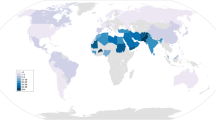Abstract
In this study, we assessed and established an allelic frequency database of Malayalam-speaking population of south western Indian state Kerala, using 15 polymorphic short tandem repeats (STRs) genetic markers. For this study, 464 unrelated healthy individuals were randomly selected following the ethical standards. The most polymorphic and most discriminating locus was D2S1338, with a value of 0.860 and 0.968, respectively. The range of heterozygosity extended from a minimum of 0.668 (TH01) to a maximum of 0.847 (D2S1338). The combined discrimination power (CPD) and combined exclusion power (CPE) were 1 and 0.999997861, respectively, for all 15 autosomal STR loci under study. The combined probability of match (CPM) and combined paternity index (CPI) for all 15 autosomal STR loci were found to be 9.85 × 10−19 and 4.18 × 105, respectively.
Similar content being viewed by others
References
Majumder PP (1998) People of India: biological diversity and affinities. Evol Anthropol Issues News Rev 6:100–110
Chandramouli C, General R (2011) Census of India 2011. Provisional Popul Total New Delhi Gov India
Singh P (2011) We-ness and welfare: a longitudinal analysis of social development in Kerala, India. World Dev 39:282–293
Rickham PP (1964) Human experimentation. Code of ethics of the world medical association. Declaration of Helsinki. Br Med J, 2:177
Peakall ROD, Smouse PE (2006) GENALEX 6: genetic analysis in Excel. Population genetic software for teaching and research. Mol Ecol Resour 6:288–295
Tereba A (1999) Tools for analysis of population statistics. Profiles DNA 2:14–16
Excoffier L, Lischer HEL (2010) Arlequin suite ver 3.5: a new series of programs to perform population genetics analyses under Linux and Windows. Mol Ecol Resour 10:564–567
Takezaki N, Nei M, Tamura K (2009) POPTREE2: software for constructing population trees from allele frequency data and computing other population statistics with Windows interface. Mol Biol Evol 27:747–752
Hammer Ø, Harper DAT, Ryan PD (2001) PAST: paleontological statistics software package for education and data analysis. Palaeontol Electron 4:9
Ghosh T, Kalpana D, Mukerjee S, Mukherjee M, Sharma AK, Nath S, Rathod VR, Thakar MK, Jha GN (2011) Genetic diversity of autosomal STRs in eleven populations of India. Forensic Sci Int Genet 5:259–261
Banerjee J, Trivedi R, Kashyap VK (2005) Polymorphism at 15 short tandem repeat AmpFℓSTR® Identifiler™ loci in three aboriginal populations of India: an assessment in human identification. J Forensic Sci 50:JFS2005151–JFS2005156
Singh A, Trivedi R, Kashyap VK (2006) Genetic polymorphism at 15 tetrameric short tandem repeat loci in four aboriginal tribal populations of Bengal. J Forensic Sci 51:183–187
Shrivastava P, Jain T, Trivedi VB (2015) Genetic polymorphism study at 15 autosomal locus in central Indian population. Springerplus 4:566
Imam J, Reyaz R, Singh RS, Bapuly AK (2017) Genomic portrait of population of Jharkhand , India , drawn with 15 autosomal STRs and 17 Y-STRs. 1–2. https://doi.org/10.1007/s00414-017-1610-x
Srivastava A, Kumawat R, Dixit S et al (2019) Genetic data for PowerPlex 21™ autosomal and PowerPlex 23 Y-STR™ loci from population of the state of Uttar Pradesh, India. Int J Legal Med:1–3
Balamurugan K, Kanthimathi S, Vijaya M, Suhasini G, Duncan G, Tracey M, Budowle B (2010) Genetic variation of 15 autosomal microsatellite loci in a Tamil population from Tamil Nadu, Southern India. Legal Med 12:320–323. https://doi.org/10.1016/j.legalmed.2010.07.004
Kumawat RK, Shrivastava P, Shrivastava D, Mathur GK, Dixit S (2019) Genomic blueprint of population of Rajasthan based on autosomal STR markers. Ann Hum Biol. https://doi.org/10.1080/03014460.2019.1705390
Besecker J, Peri G, Davis M, Zubizarreta J, Hampikian G (2018) Allele frequencies of 15 STR loci (Identifiler™ kit) in Basque-Americans. Legal Med 31:17–19. https://doi.org/10.1016/j.legalmed.2017.12.009
Tong D, Chen Y, Ou X, Chen W, Liu S, Zhang Y, Sun H (2013) Polymorphism analysis and evaluation of 19 STR loci in the Han population of Southern China. Ann Hum Biol 40:191–196
Kido A, Dobashi Y, Hara M et al (2006) STR data for 15 AmpFLSTR Identifiler loci in a Tibetan population (Nepal). Int Congr Ser 1288:349–351. https://doi.org/10.1016/j.ics.2005.08.037
Kraaijenbrink T, van Driem GL, Tshering of Gaselô K, de Knijff P (2007) Allele frequency distribution for 21 autosomal STR loci in Bhutan. Forensic Sci Int 170:68–72. https://doi.org/10.1016/j.forsciint.2006.04.006
Liu J, Guo L, Qi R, Li SY, Yin JY, Zhang W, Sun Z, Tian X, Gao B (2013) Allele frequencies of 19 autosomal STR loci in Manchu population of China with phylogenetic structure among worldwide populations. Gene 529:282–287. https://doi.org/10.1016/j.gene.2013.07.033
Gayden T, Mirabal S, Cadenas AM, Lacau H, Simms TM, Morlote D, Chennakrishnaiah S, Herrera RJ (2009) Genetic insights into the origins of Tibeto-Burman populations in the Himalayas. J Hum Genet 54:216–223. https://doi.org/10.1038/jhg.2009.14
Yoo SY, Cho NS, Park MJ, Seong KM, Hwang JH, Song SB, Han MS, Lee WT, Chung KW (2011) A large population genetic study of 15 autosomal short tandem repeat loci for establishment of Korean DNA profile database. Mol Cells 32:15–19
Author information
Authors and Affiliations
Corresponding author
Ethics declarations
Ethical approval
The study was approved by the ethical committee of Banaras Hindu University, Varanasi, India (Ref. No. I.Sc./ECM-XII/2018-19/06).
Conflict of interest
The authors declare that they have no conflict of interest.
Additional information
Publisher’s note
Springer Nature remains neutral with regard to jurisdictional claims in published maps and institutional affiliations.
Rights and permissions
About this article
Cite this article
Sreekumar, R., Thekkatavan, A., Shrivastava, P. et al. Allelic frequency database of 15 polymorphic autosomal STRs in the Malayalam-speaking population of Kerala, India. Int J Legal Med 134, 1679–1681 (2020). https://doi.org/10.1007/s00414-020-02286-0
Received:
Accepted:
Published:
Issue Date:
DOI: https://doi.org/10.1007/s00414-020-02286-0




